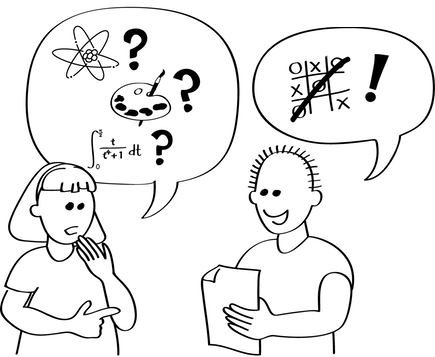Artificial Intelligence
The Intelligent Piece of Paper #
This activity explores what it means for a computer to be intelligent, but having the students interact with a piece of paper that contains rules for playing a perfect game of noughts-and-crosses (tic-tac-toe). The activity contains some thought provoking (and humorous) discussion questions.
Contributed by: Paul Curzon

Activity description (PDF) #
- Instructions for Intelligent Paper activity (English)
- Intelligent Paper (Greek)
- Intelligent Paper (Slovenian)
Videos #
Related Resources #
More activities:
- Computer Science For Fun (CS4FN) has:
- A classroom activity called The Intelligent Piece of Paper where you can hold a competition between an artificial intelligence: a “highly intelligent piece of paper” and a human. In this ongoing challenge between the best of humanity and the best of paper-kind the paper has an unbeaten record. It is yet to lose a game of noughts and crosses.
- A classroom activity called Winning at Noughts and Crosses where you explore programming without worrying about programming languages and investigate how a computer is able to win at board games like chess, by writing instructions to play perfectly at noughts and crosses followed by a tournament to find the best.
- A classroom activity called The Brain-in-a-Bag. Download the related Powerpoint Slides. After explaining how neurons in the human brain work we create an artificial version that is programmed to play Red-black snap. We then test it against other artificial brains.
- A classroom activity called The Emotional Robot. Download also Video: Emotional Robot. This short (1 minute) video demonstrates a robot created by a University student that reacts to the tone of a speaker’s voice. It responds by changing its expression to suggest emotions such as happy, sad and surprised.
- A classroom activity called Create-a-Face. The class make an affective (relating to moods and emotions) robot face out of card, tubes and themselves. It is programmed to react to different kinds of sounds (nasty, nice or sudden) and show different emotions (sad, happy, surprised). The class then think up some other facial expressions and program sets of rules to make the face show them to appropriate sounds.
- A classroom activity called The Sweet Learning Computer. Download the related Boards. The class challenge a machine made of sweets to the game of Hexapawn (a little like a game of chess with only pawns and on a 3×3 board). At the start the machine only knows the basic rules of the game. The more it plays the better it gets: when it loses the class punish it by eating its sweets allowing it to learn from its mistakes.
Curriculum Links #
Great Principles of Computer Science #
- Automation
- Computation
